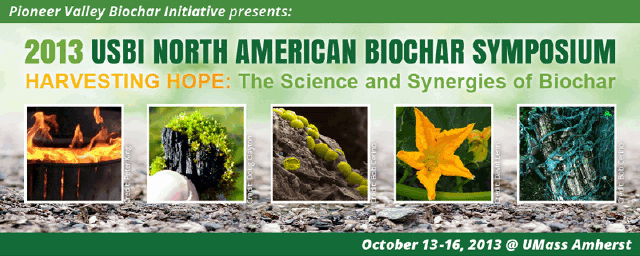Policy & Community Engagement
Recycling the Biosphere
Ron Larson presentation
Knight2013.pdf (1973 kB)
Erich Knight presentation
Location
CC 165
Start Date
14-10-2013 1:30 PM
End Date
14-10-2013 2:50 PM
Session Description
Entropy, Order and Information in Biochar Structure and Climate Stability: Daniel Young
A review of thermodynamic principles relating to the initiation and evolution of life and the effectiveness of biochar. Non-equilibrium thermodynamics and the emergence of complexity and design in open systems. The importance of pattern and extra-cellular matrix in ecosystem regeneration. The role of biochar in implementing these principles.
The Perception of Biochar within the Geo-engineering Community: Ronal Larsen
Geoengineering or “Climate engineering” is defined differently by different groups but to all it implies large-scale modification of the environment for climate reasons. . Geoengineering has (or should have) two distinct parts. The first and most controversial is Solar Radiation Management (SRM). Biochar is often inaccurately and unfortunately placed in this category, even though SRM specifically refers only to changing the earth's albedo (a measure of light reflection). Only a few approaches are usually mentioned – injecting sulfur compounds and “whitening” clouds.
The second Geoengineering category is called Carbon Dioxide Removal (CDR). Biochar certainly fits here, but biochar proponents are mostly ignoring this topic. Biochar enthusiasts are mostly interested in soil improvement, albeit recognizing biochar's potential CDR/NET benefits. Biochar has 5-6 major competitors in this category – the most serious being “BECCS “(Biomass Energy with Carbon Capture and Storage. The advantages and disadvantages of these competitors will be described.
But mainly the talk will focus on how the members of the Google group called “Geoengineering” are reacting to the concept of biochar. Some emphasis will be placed on what seems to drive opinions of this expert group – topics such as size of the supporting organizations (IBI, etc), funding, active countries, ethical issues, arctic ice disappearance, etc. Most important is the perceived size of the biomass resource.
Agriculturally Engineering the Biosphere: Erich Knight
A review of new research concerning Soil Carbon, Carboniferous Aerosols, extent of Pyrolytic-Carbon fraction in soil and the first survey of the extensive deep soil carbon sink.
Recycling the Biosphere
CC 165
Entropy, Order and Information in Biochar Structure and Climate Stability: Daniel Young
A review of thermodynamic principles relating to the initiation and evolution of life and the effectiveness of biochar. Non-equilibrium thermodynamics and the emergence of complexity and design in open systems. The importance of pattern and extra-cellular matrix in ecosystem regeneration. The role of biochar in implementing these principles.
The Perception of Biochar within the Geo-engineering Community: Ronal Larsen
Geoengineering or “Climate engineering” is defined differently by different groups but to all it implies large-scale modification of the environment for climate reasons. . Geoengineering has (or should have) two distinct parts. The first and most controversial is Solar Radiation Management (SRM). Biochar is often inaccurately and unfortunately placed in this category, even though SRM specifically refers only to changing the earth's albedo (a measure of light reflection). Only a few approaches are usually mentioned – injecting sulfur compounds and “whitening” clouds.
The second Geoengineering category is called Carbon Dioxide Removal (CDR). Biochar certainly fits here, but biochar proponents are mostly ignoring this topic. Biochar enthusiasts are mostly interested in soil improvement, albeit recognizing biochar's potential CDR/NET benefits. Biochar has 5-6 major competitors in this category – the most serious being “BECCS “(Biomass Energy with Carbon Capture and Storage. The advantages and disadvantages of these competitors will be described.
But mainly the talk will focus on how the members of the Google group called “Geoengineering” are reacting to the concept of biochar. Some emphasis will be placed on what seems to drive opinions of this expert group – topics such as size of the supporting organizations (IBI, etc), funding, active countries, ethical issues, arctic ice disappearance, etc. Most important is the perceived size of the biomass resource.
Agriculturally Engineering the Biosphere: Erich Knight
A review of new research concerning Soil Carbon, Carboniferous Aerosols, extent of Pyrolytic-Carbon fraction in soil and the first survey of the extensive deep soil carbon sink.



Bio and Photo
Dan Young is a graduate of the University of California at Berkeley with a BS in Chemical Engineering. He took a Master-of-Science degree in Environmental Science from the New Jersey Institute of Technology. He has worked in the fields of chemical process engineering and water and waste treatment technology. As a Chemical Engineering Consultant he worked in energy and process efficiency matters and in environmental process design. Dan formed his own consulting firm, DAY Environmental Engineering, Inc. doing environmental process and waste treatment design, and environmental site assessment and remediation work.
Ron Larson is an advisor to IBI and a board director of USBI. He is a retired Electrical Engineer; Professor at Georgia Tech, Branch Chief and Principal Scientist at SERI (now NREL). Former Chair ASES Now principally active in 1) Colorado PUC as intervenor (mostly DSM topics) and 2) promoting Biochar (negative carbon, soil augmentation).
Erich J. Knight, an ornamental gardener of 33 years, has spent the last seven years advocating for thermal conversion of biomass. He has been directly involved in several projects concerning soil carbon at James Madison University, as well as conference planing & presentations at ISU and CU Boulder and Sonoma State in 2011. Erich is working to integrate the many applications of Biochar for enteric health as a feedstuff in animal husbandry, for mine scarred lands as an in situ bioremediation for a host of toxic agents and pesticides. His goal is total symbiotic integration of nutrients, carbon and energy by the husbandry of whole new orders and kingdoms of life. Erich's networking efforts have lead to collaborative field trials with the Rodale Institute , DuPont & ORNL for brownfield remediation trials, and dissemination of char practices to academic & grass-roots organizations. Additionally he has provided editorial assistance on topical articles and the leading books; "The Biochar Solution" & "The Biochar Revolution". His policy & research lobbying efforts with the USDA, USGS, DOE, NOAA, NASA and EPA lead to a briefing of the EPA chiefs of North America at the 2011 Commission for Environmental Cooperation.